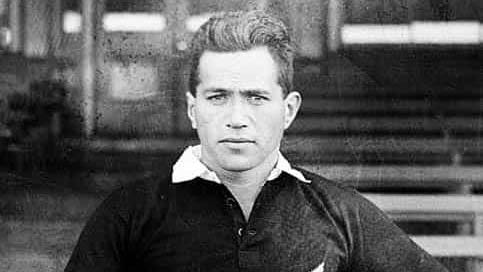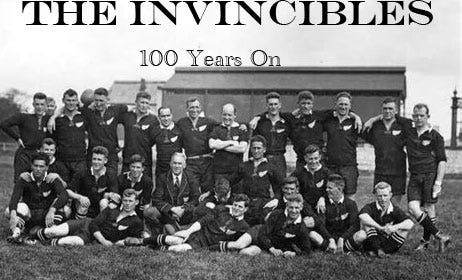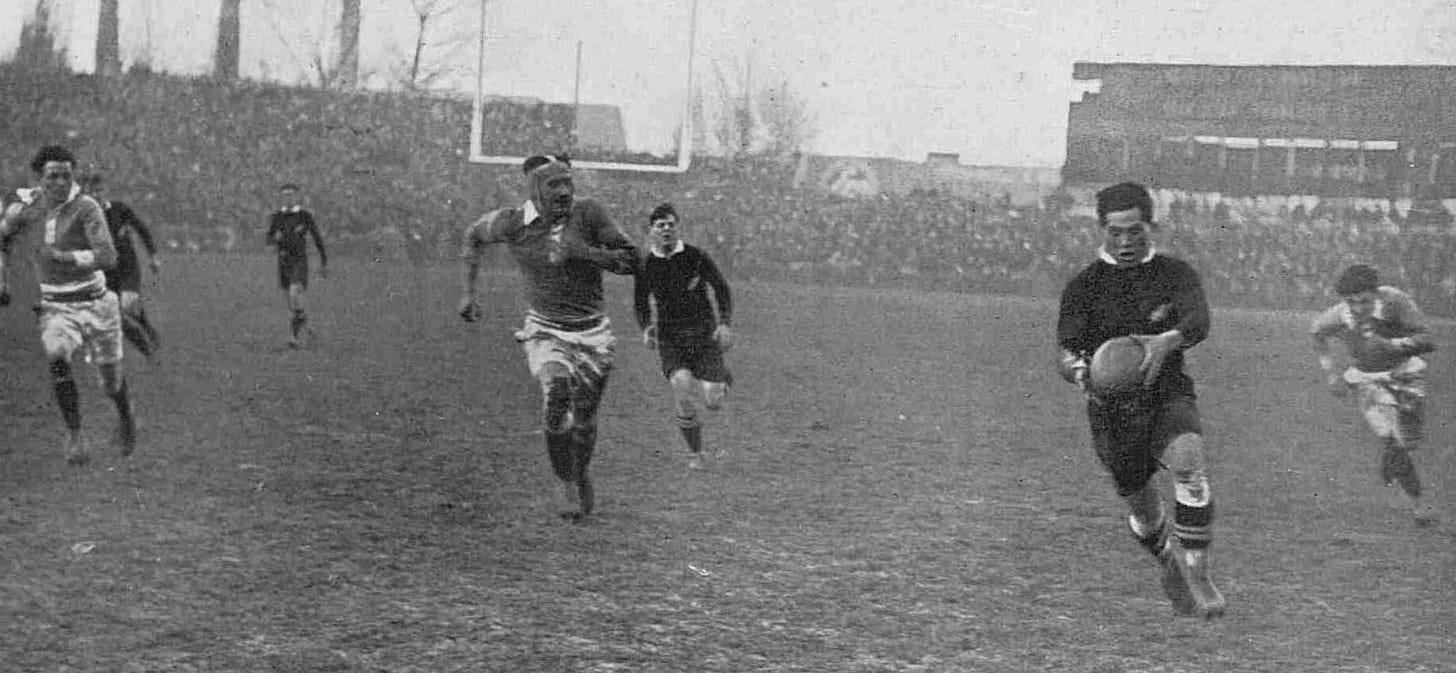In the history of New Zealand sport, and certainly in rugby, there can have been no more impressive demonstration of endurance than that achieved by George Nepia on the 1924-25 tour with the Invincibles.
A month before the team was selected, he had never played fullback in a game with any consequence. His play was criticised while in Australia on the warm-up tour - basically a fundraiser for New South Wales rugby on its 50th jubilee. He was rubbished on his display in Auckland just over 12 hours after the completion of a voyage from hell from Australia.
But once free of the baggage of armchair experts, and on the high sea to England, Nepia concentrated on the job ahead. On board the ship, he told Andrew 'Son' White,
I'll show the so-and-sos I can play fullback' – and by hell, he did.[1]
Upon arrival, he wasted no time adapting to British rugby, and the longer the tour progressed, the higher his reputation soared.
George Nepia photographed near the end of his playing career in 1935
It cannot be understated what he achieved in playing every game on the tour from 5 July against New South Wales until the final game at Victoria, Vancouver. Apart from appearing in 38 consecutive games, such were the demands on the touring schedule that he played two games in three days, five times!
That happened twice within the first five games. The games involved were Cornwall-Somerset on 18 and 20 September, Gloucestershire-Swansea on 25 and 27 September, Newport-Leicester on 2 and 4 October, Oxford-Cardiff on 20-22 November, and Warwickshire-Combined Services on 11-13 December.
The most consecutive game by any other player was Bill Irvine's 14. Read Masters played 11 consecutive games, while Len Cupples played nine consecutive games. Several others, Jock Richardson, Maurice Brownlie and Bert Cooke, at one stage, played eight consecutive games. Brownlie, 'Snowy' Svenson and Neil McGregor each played seven-game stints.
The feat alone was significant, but add in his contribution, especially defensively, and it is all the more creditable.
Nepia's career started at Māori Agricultural College near Hastings. While at school, he formed a combination in the five-eighths with Lui Paewai that took them to representative rugby for Hawke's Bay in 1923. Earlier, in 1921, Nepia played on the wing in a trial game for the East Coast Māoris against the Rest at Hastings when a Māoris tour of Australia was intended. But the tour did not take place.
A year later, Nepia played for Hawke's Bay against Wairarapa on the wing in the first half before moving to second five-eighths in the second. As he had in the trial game, he scored a try. He also played against New Zealand Māoris before their 1922 tour of Australia.
Such was the impression Nepia made in those games that he was included in the NZ Māoris team to tour Australia in 1923, but he was unable to travel, possibly because he was still at school. However, he and Paewai were first paired for Hawke's Bay in their third Ranfurly Shield defence of their historic tenure, and the first of the season, against Wairarapa for a 6-0 win. Nepia appeared in every game that season, scoring 52 points for them. In the 10-6 over Wellington, one critic said Nepia was 'a revelation to the visitors.'
Chapter 4 covered Nepia's rise in 1924 through the trials process, but it was interesting that one critic said after his performance for Southern Māori that he was wasted at fullback.
Arthur Carman recounted Nepia's performance in the North Island Possibles v Probables trial in Wellington, the game before Billy Wallace instructed him on fullback play. Nepia converted a try, landed a penalty goal and a dropped goal in his side's 21-23 loss.
I well remember how as he stemmed attacks, put in powerful kicks to touch, and started passing rushes, he soon became the favourite of the crowd, and crowned an unblemished afternoon's work with his goal from the field.[2]
Selected to play for the North Island, the first of only three appearances he made in the inter-island game, he built on his fan following as the North enjoyed a substantial win.
It can be said that Nepia clinched the right to be regarded as one of the best fullbacks the Dominion has produced for many years past. He is the surest taker of the ball in the air who has appeared in this responsible position, and is also the mightiest punter. He came through the heavy defensive work with flying colors [sic], hurling himself with the greatest determination, right at the feet of the oncoming big South Island forwards.[3]
Nepia failed to build on his reputation in the pre-tour visit to Australia. He didn't make mistakes; he just didn't live up to fans' expectations of him.
His contributions to games throughout the tour are covered elsewhere in this series, but it was evident from early on that he was a special player, equipped to cope with all that British and Irish rugby could throw at him with a fearlessness that defied understanding.
Carman was impressed with Nepia's endurance in playing every match of the 30 games of the Invincibles tour.
Nepia never flinched. Nepia played consistently well, and often was brilliant. It was inspiring to those of us who were fortunate enough to witness the matches played, to see George guarding the goal line match after match, imperturbable, unmoved, reliable. All I can say is that no one who has not seen Nepia play in England, has seen Nepia as he was. He was the idol of all the crowds, and remained unspoiled through it all.[4]
Carman concluded his profile by saying that Nepia was the best-known name in the rugby world.
George Nepia breaks against a French Selection in Paris in 1925 (NZ Rugby Museum)
Years later, respected Welsh and, British & Irish Lions fullback and Sunday Times journalist Vivian Jenkins recalled a description of Nepia made by another writer, Denzil Batchelor[5], who covered the tour.
He was between short and tall, and his thighs were like young tree trunks. His head was fit for a prow of a Viking longship, with its passionless sculpted bronze features and plume of blue-black hair. Behind the game, he slunk from side to side like a black panther behind bars, like a lord of the jungle on the prowl for a kill.[6]
In a discussion celebrating 60 years of Twickenham, Dai Gent and Jenkins, rugby writers for the Sunday Times at different times, discussed the greatest fullbacks they had seen.
Gent said Nepia edged Bob Scott in his view.
He was the better tackler and to see him going down to a forward rush, or hurling himself into a tackle, was a sight never forgotten. He was absolutely fearless, strong as an ox, and had the knack of diving head first at the feet of the opposing forwards and always coming out on the other side with the ball in his hands.
He could punt huge distances with either foot and was an accomplished drop-kicker and place-kicker.[7]
Long-time British critic Col. Philip Trevor said Nepia stood alone among fullbacks of the era, and his record was 'marvellous'.
His pluck is equal to his play, and that is saying a good deal.[8]
One of the leading British sportswriters at the time of the tour, C.W. Packford, said in a Sporting Life column in 1928 that while there had been more accomplished and artistic backs, 'we have rarely seen one so completely regardless of personal danger and yet so utterly dependable.'[9]
Packford said Nepia had a tendency to gamble in his play, but the gambling was from a player who realised only the most extreme measures would save the situations he faced, and he had never faltered in going through with his actions.
Of all the touring players who impressed, he felt Nepia was the one who made the deepest impression.
Nepia, who was not twenty years of age when he reached the shores of England, was a magnificently built athlete. Although he is 5ft 9 in height, owing to the abnormal width of his chest and his sturdy limbs, he appeared shorter than he actually was, but when that 13 st of 'dynamite' went into action, everyone opposed him was fully aware of the fact...In his first game at Devonport, it was apparent that he would be a complete success in this country, but as he played on that occasion, he improved out of all knowledge as the tour proceeded.
I always thought that Nepia was at his best on a heavy ground, for no matter how holding were the conditions, how elusive was the ball, his handling and kicking, in such case, were beyond reproach. Nepia was faster than he appeared to be, but there were occasions when he was beaten for pace when the ground was favourable for the man of speed. One of these was in the match with England at Twickenham, an encounter that, owing to him being out-paced, would undoubtedly have resulted in a victory for the Mother Country had it not been for sheer misfortune. During that unforgettable period when England rallied so brilliantly as to hold out hopes of completely reducing a rather formidable adverse margin of points, J.C. Gibbs, the flying Harlequin, twice defeated Nepia for speed, punted over his head, left the New Zealander literally standing still, only to see the ball bounce yards in the wrong direction when all he would have had to do was to touch down.
It is rarely, however, that he was so outwitted, and he had the satisfaction of knowing at the end of the tour that his wonderful consistency, stamina, and strength contributed as much as anything else to the superb record of the team. Nepia was absolutely devoid of fear. How he was not injured time and again was miraculous, for he took every risk imaginable.
He provided many a thrill. To see him facing a determined rush of English, Irish, or Welsh forwards was unforgettable. For an appreciable moment, he would stand with his hands on his thighs as if weighing up the situation. Then there would be the flash of a dark-clad figure, a daring dive among the oncoming forwards, the ball would be clutched fiercely, and Nepia would go crashing backwards through the heaviest and most powerful of packs.
Nepia was also rather a terrible fellow when it came to tackling. He may not have been a Gamlin, but the man around whom he threw his arms took no further part in the particular movement in which he was engaged. Another valuable characteristic of this popular athlete was his ability to open out the game. He did not always kick for touch on fielding the ball; at the slightest opportunity, he would run into such a position that he was about to put his colleagues into favourable possession. We have had several redoubtable fullbacks from the Dominion in the past, but there is not one who has made a greater impression or who has been more supremely successful than Nepia.[10]
FJ Sellicks said Nepia gave the side 'splendid service.'
He has been a picturesque figure, very strongly built, with some pace, and an idea of opening up the game. He has been described as the greatest fullback in the history of Rugby, which is, of course, sheer nonsense. Such a statement could only be made by the very ignorant or the very prejudiced, and it is not fair to the boy himself. But considering that he has only just taken to the fullback position, there is no doubt that he has done extraordinarily well, and he may easily develop into a real phenomenon. No one has ever caught or fielded the ball with more accuracy and during the tour his kicking has improved in consistency and length, finishing up with a really fine display against England.[11]
Nepia was a controversial omission from the 1926-27 Māori All Blacks tour of France, Britain and Ireland and the 1928 All Blacks tour of South Africa. He did play in the 1930 series against the touring British & Irish side and continued playing rugby regularly until 1935, before a stint in rugby league. After being reinstated to rugby, his last first-class game was for the Olympians in 1950. In his career, he played 129 games and scored 396 points. Taking up refereeing, he had 10 first-class appointments between 1948-58, and in one game between East Coast and New South Wales Country, he ordered three players from the field.
[1] Andrew 'Son' White, quoted in I George Nepia, by George Nepia and Terry McLean, London League Publications Ltd, London, 2002.
[2] Arthur Carman, The 1924 All Blacks – Putting Facts on Record, Daily Telegraph (Napier), 23 September 1927. Carman, who covered the 1924-25 All Blacks tour, wrote profiles of each member of the side that appeared in several newspapers around the country.
[3] The Dominion, 2 June 1924
[4] Carman ibid
[5] Denzil Batchelor wrote an extensive, and often-quoted appreciation of George Nepia in his book Days Without Sunset, Eyre and Spottisoode, London, 1949
[6] Batchelor, quoted by Vivian Jenkins, Sunday Times Magazine, London, 27 October 1991
[7] Dai Gent, Sunday Times, London, 22 November 1959
[8] Col. Philip Trevor, Daily Telegraph, 6 January 1925
[9] C.W. Packford, Sporting Life, 1928
[10] C.W. Packford, Sporting Life, November 1928
[11] FJ Sellicks, The Cricketer, January 1925





